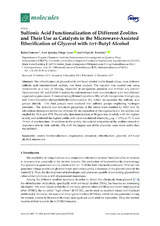Sulfonic Acid Functionalization of Different Zeolites and Their Use as Catalysts in the Microwave-Assisted Etherification of Glycerol with tert-Butyl Alcohol
Autor
Iglesias, Ivan
Luna, Diego
Bautista, Felipa M.
Estévez, R.
Editor
MDPIFecha
2017Materia
Zeolite functionalizationOrganosilica precursor
Etherification
Glycerol
Tert-butyl alcohol
Microwave
METS:
Mostrar el registro METSPREMIS:
Mostrar el registro PREMISMetadatos
Mostrar el registro completo del ítemResumen
The etherification of glycerol with tert-butyl alcohol in the liquid phase, over different
sulfonic acid functionalized zeolites, has been studied. The reaction was carried out using
microwaves as a way of heating, measured at autogenous pressure and without any solvent.
Dealuminated HY and HZSM-5 zeolites by acid treatment were functionalized with two different
organosilica precursors: 3-mercaptopropyltrimethoxysilane (M), which incorporates thiol groups,
and 2-(4-chlorosulfonylphenyl)ethyltrimethoxysilane (C), which incorporates the sulfonic acid
groups directly. The thiol groups were oxidized into sulfonic groups employing hydrogen
peroxide. The textural and structural properties of the solids were studied by XRD and N2
adsorption–desorption isotherms, whereas the incorporation of the organosilica in the zeolites was
studied by TGA and XPS. The novelty functionalization of M gave rise to solids with the highest
acidity, and exhibited the highest yields with more substituted ethers (Yh-GTBE = 13%), at 75 C and
15 min of reaction time. In addition to the acidity, the textural properties of the zeolites played an
important role in their activity; HY, with the largest size of the channels, were more active than
the HZSM-5.

